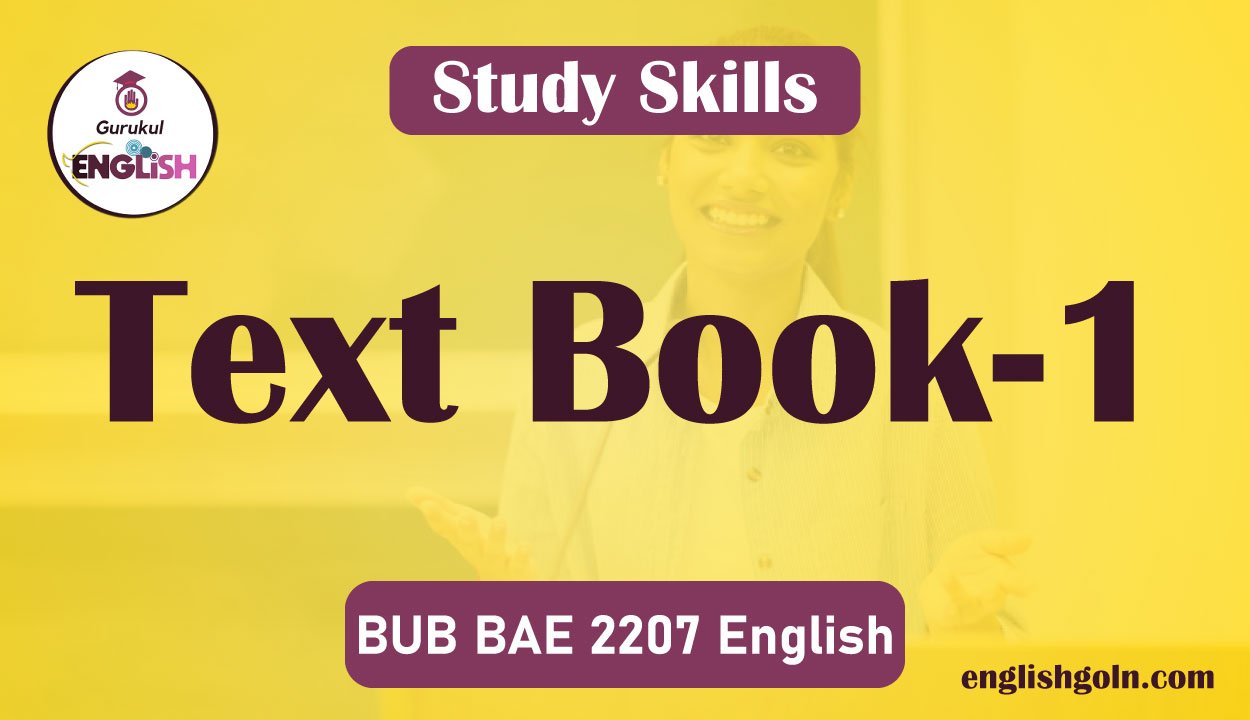Today our topic of discussion is- Text book-1
Text book-1
In your courses, you will have textbooks to study. If you know how to use a text book efficiently and methodically, it will be much helpful for your study.
Objectives:
After completing this lesson you will be able to: use a textbook efficiently tell what the essential reading skills are.
Situation: Reading
There are different types of reading.
Serious reading:
When you are for serious study, for example, when you need to know the views of an eminent literary critic, you pay keen attention to everything the critic says and opines.
This won’t be an easy task to read quickly. You need to read the text very carefully to understand and analyse the key points. This is called “Serious Reading.”
Average reading:
Sometimes we just want to relax and read something. This reading is not that serious and is meant for enjoyment. With this purpose we may read a fiction, a story or an easier textbook or a newspaper article. In such cases it is not that important to follow an argument closely. This sort of reading can be specified as “Average Reading.”
Skimming:
Sometimes we want to find out very quickly what a book is all about. In this task we glance at the titles and contents of the book. We just read some parts of the book because we only want to have a general or overall idea of what the book is about. We read it very quickly first to get a general idea. This is called “Skimming.”
Situation : Three reading approaches.
There are three reading approaches Reading to get
- a general overall picture of a subject.
- a detailed, organized knowledge of facts and ideas.
- a reference, or answer to a detailed specific question.
When we are to read a book, first we may try to get a general overall picture of the book so that we can decide whether to read the whole book or just to read parts of the book in detail. This is called “Survey”. Have you ever noted what do we generally find in a book? A book generally contains:
- The title page
- Preface or foreword
- Table of contents
- The Text.
The title page: The title page tells us about
1. the title of the book, i.e. the general subject area of the book
2.. the author of the book the date of publication of the book.
Preface or foreword:
Preface or foreword of a book indicates about the purpose of the book, that is, why the book is written and for whom it has been written. Just by reading the foreword you may decide whether it would be useful for you to read the book or not. A lot of time may be saved by reading the foreword before going through the book. From the foreword you will know if the book will serve your particular purpose of reading.
Table of contents:
Table of contents helps us to find out what is there in the book. This table is usually placed at the beginning, after the title page. It lists the order of the chapters and provides the first page number for each chapter. It will also list the appendices, bibliographies, glossaries and indexes if there are any. It will show you what is covered in the book and possibly how one part is related to another.
The Text:
Now, keeping an eye on the chapter headlines, you can flick through the pages quickly. There may be other headings and summaries of chapters. The first paragraph of the chapter usually contains the topic or thesis or the main theme of the chapter. The last paragraph of a chapter sometimes sums up what the author has been saying. So, reading the first and the last paragraphs is very important in some cases. If there is an index in the book you shall be able to look up a specific topic in an alphabetical list with a page reference.
Review Questions : Answer the following questions.
1. What is ‘Serious Reading”?
2. What is ‘Average Reading?
3. What is ‘Skimming”?
4. What are the three reading approaches?
5. Why do we survey?
6.. How is a book generally arranged?
7. What does the title page tell you?
8. What do you know from the preface?
9. What is learnt from the ‘Table of Contents?
10. Choose two textbooks – Compare them in details. Now, write down
a. The title of the book, the author’s name, the place, and date of publication.
b. Is there any preface, or foreword on the introduction? Who is the book for?
C. How much information does the ‘contents’ provide?
d. Is the text interesting? Are there summaries of notes at the end of each chapter? Are there pictures, diagrams or tables?
e.Is there a glossary and a bibliography? Are they detailed?
f. Which book do you find more appealing and why?
